I was recently asked to give a presentation on ‘Image and Mountain Biking’, as part of an event held by Ride Sheffield under the topic ‘Reframing Mountain Biking’. The event brought together a range of people from brands, media, trail associations and the MTB industry to consider what the mountain bike community might do to help attract a wider range of people, and to help improve trail access. Manon Carpenter played a big part in pulling the event together, and it certainly continued discussion of the issues raised in her film Trails on Trial, where she examined what it takes for mountain biking to become an accepted, thriving part of communities.
Since you probably weren’t there, I thought I’d bring you the gist of my contribution to the day…
Firstly, let’s consider who actually sees mountain biking. Obviously, people who ride mountain bikes see it. People who share spaces with us – like dog walkers, or trail runners, or horse riders – they see us. We’ll come back to them… People who ride other sorts of bikes, they probably see us, even if it’s only in the form of a general awareness that there are some big bouncy bikes in the bike shop that look quite different to their own road bike/hybrid/commuter etc.
But what about the wider public? Do they have a sense of what mountain biking is, or who does it?
Latest Singletrack Merch
Buying and wearing our sustainable merch is another great way to support Singletrack
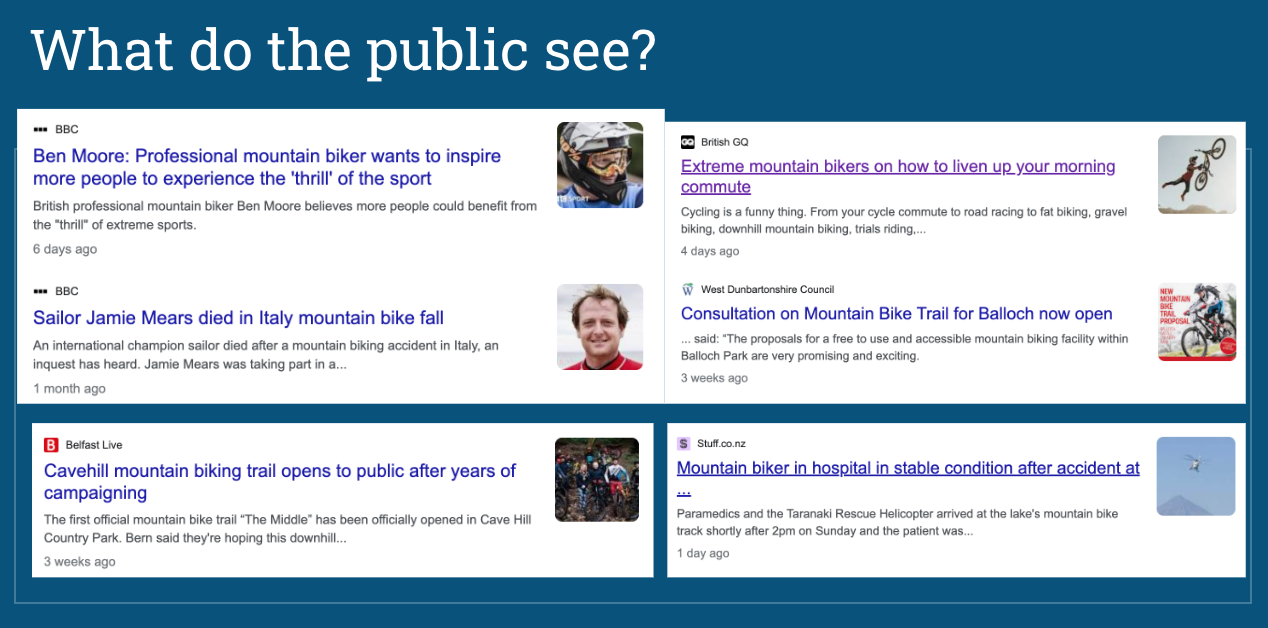
If you’re not into bikes, you’re probably not flicking through a bike magazine, or scrolling through a bike website. In which case, any information about mountain bikes or mountain biking that you get has got to make its way to you through generic news sites, or perhaps lifestyle magazines. Scour through Google news results for ‘mountain biking’, exclude the results from bike-specific sites, and you get… almost nothing. What there is tends to be local newspapers reporting on rescues, injuries, and the occasional local hero story (often with them overcoming injury…). Danger, risk, and injury – hardly a sales pitch. And this is especially relevant when you consider that the other appearance that mountain biking makes in the local newspaper is over the occasional consultation about a potential new trail. Why would anyone support more mountain biking trails if all they see is an extra burden on the local hospital?
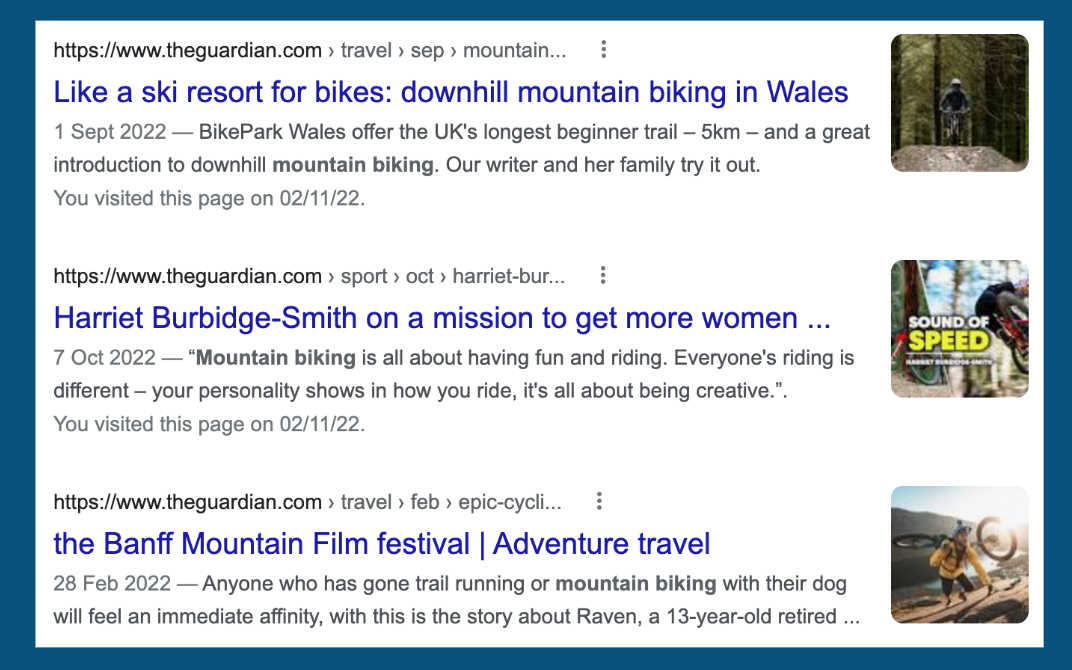
Away from Google, what might you see if you read a national newspaper? The Guardian is a fairly pro-cycling publication that doesn’t partake in the ‘war on cyclists/Lycra louts/wHy dON’t thEy haVE licEnse platEs’ type rhetoric to be found in some corners of the media. So perhaps in the Guardian we might find our non-mountain biking friends at least learning something positive about it? Again, search results reveal almost nothing. A couple of good features – one describing what Bike Park Wales is like, and another where the freerider Harriet Burbidge Smith describes how and why she wants to get more women into mountain biking. But that’s about it.
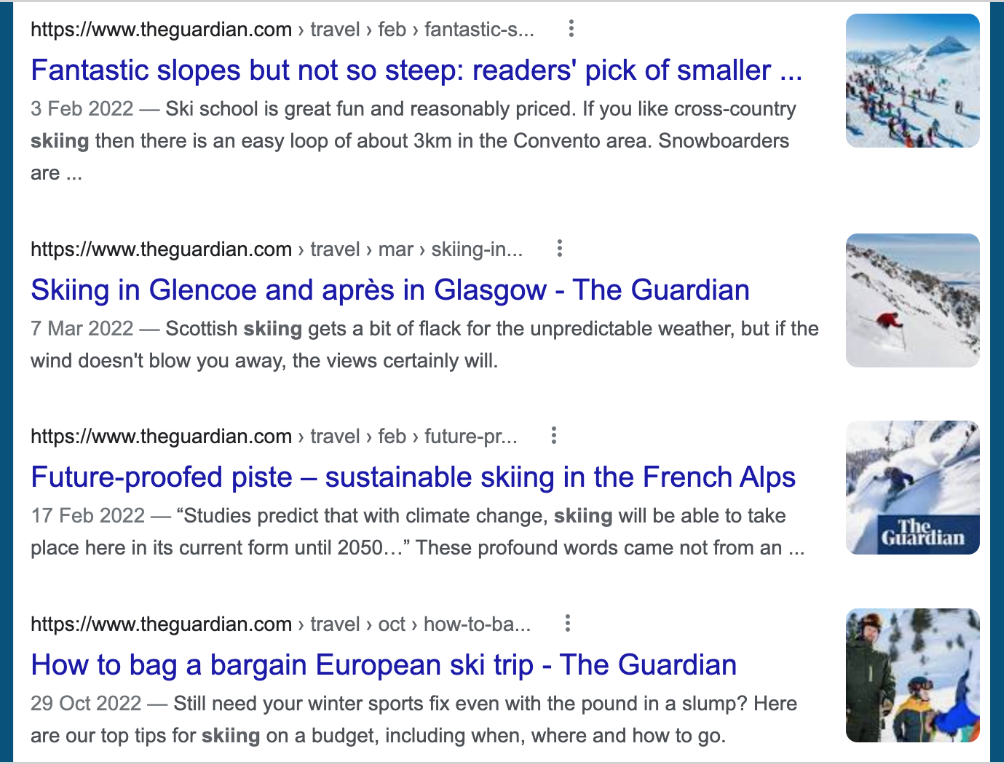
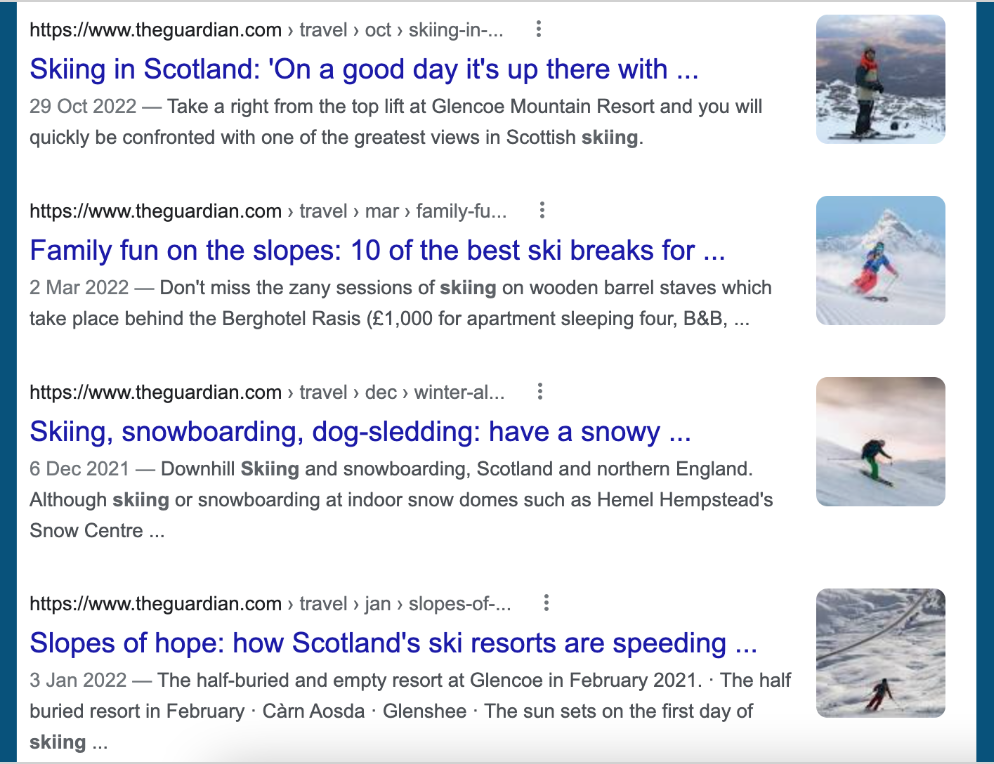
By way of contrast, if you look at how often you might read an article about skiing in the Guardian, you get a couple of pages of results. These articles tell you where to ski with a family, where to ski on the cheap, where to go if you’re a beginner, other fun things to try out in the snow, après ski, how to be more sustainable with your skiing… the list goes on. Skiing comes across as a fun activity – something you could learn to do on a holiday, or even that you’d book a holiday specifically to learn to do. There’s no endless list of news stories about skiers injuring themselves, though surely it must be very similar in risk profile? I’ve never skied, but between Ski Sunday and plenty of Sunday supplement style glossy stories, it comes across as something aspirational – something I’d like to have a go at. It seems pretty unlikely that an equivalent non-mountain biking reader is going to have similar thoughts about mountain biking.
If mountain biking is almost invisible in mainstream media, real life is the place where non-mountain bikers may be most likely to form their impressions of mountain biking. This brings us back to those people who share spaces with us. It’s not just other trail users, who see us on the trails or at trail heads and car parks, it’s also people who see us in cafes, pubs, shops and around the towns where mountain biking is popular.
What do they see there? Do we fall into the category of more ‘bloody cyclists’? Do we seem like intimidating groups, armour clad and eyes out of site behind goggles? Or just like groups of great friends having fun? Given the choice, would ‘outsiders’ give us a wide berth, as we might do a gang of football supporters on a train or in the pub? Or do we look approachable, perhaps more like a group of steam enthusiasts waiting for a special train to pass, when curiosity gets the better of you and you ask them what’s coming?
When we’re out there, especially with a bit of adrenaline pumping through our systems, how might we look to the uninitiated?
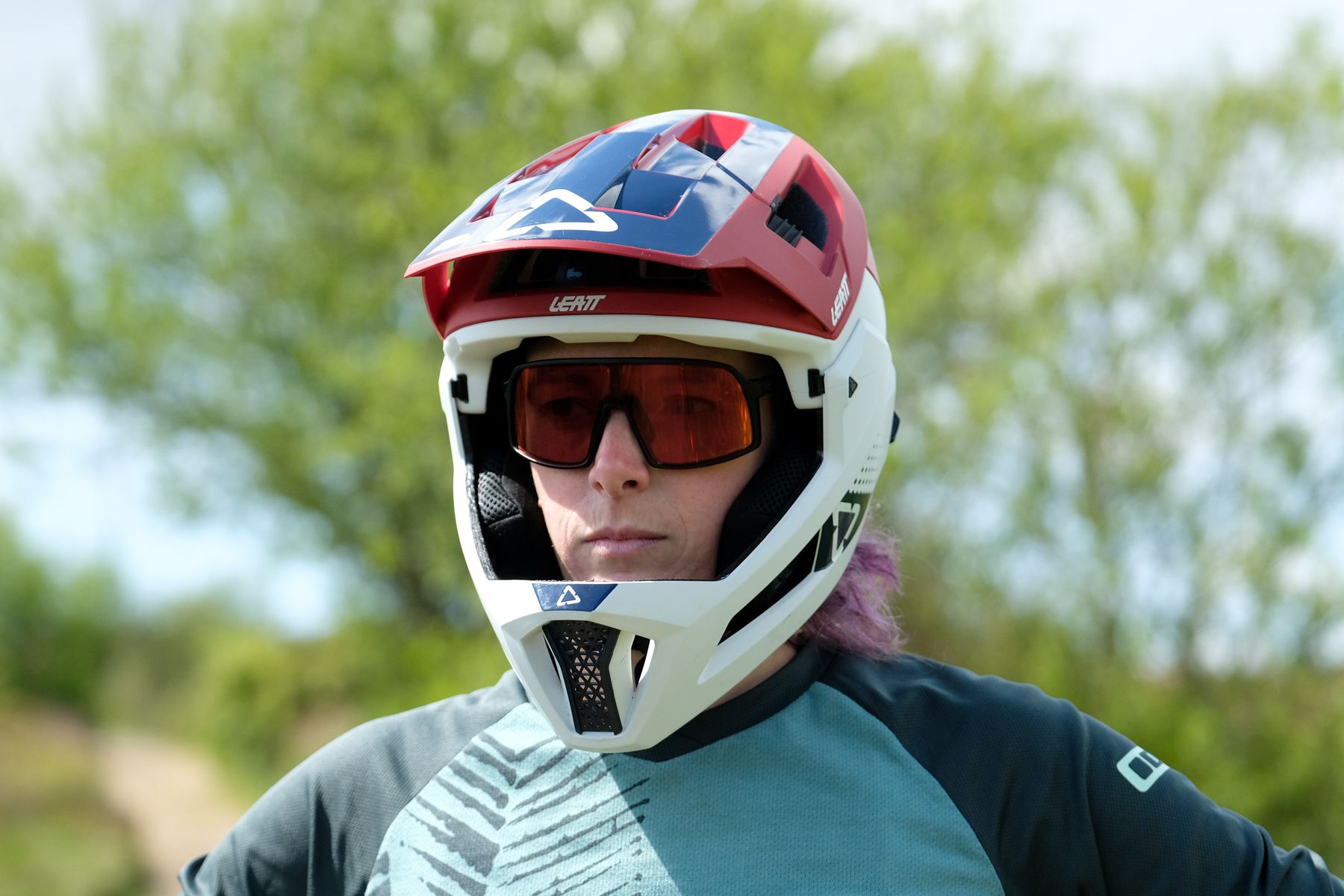
To me, all this suggests there are three types of people in this world:
- the Converted – they know about mountain bikes and like it
- the Hostile – they (think they) know about mountain biking, and they don’t like it
- the Unaware – they’ve no strong views, but probably think mountain biking is ‘scary’.
If we want people to be supportive of our calls for increased trail access, it would help a lot if more people saw the point in mountain biking, and the benefits to be had – if they saw mountain biking as a fun and desirable thing to do, rather than a vaguely dangerous one. If we could change the image of mountain biking among the Unaware and Hostile groups, we could find both new participants and new supporters.
Who are our potential ‘change makers’ or influencers? Riders can certainly play their part by behaving responsibly. The adage ‘Be Nice Say Hi’ goes a long way. But we can go further too – being seen to be a force for good, clearing up litter rather than leaving it, spending money in communities rather than dodging the parking fees. By being on our ‘best behaviour’ we can help people who encounter us have more positive experiences when they do encounter mountain bikers. Unfortunately, negative experiences are like bad restaurant reviews – they stick in the mind and carry more weight than all the positive ones. Call out your ride buddies who give us a bad name – it makes the job even harder for the rest of us.
But there’s more to be done. Mountain bikers have very little by way of a governing or national body that is doing anything to promote the image or interests of mountain biking. Developing Mountain Biking In Scotland (DMBinS) is doing a lot to push the economic benefits in Scotland, but the rest of the UK lacks such a voice. Cycling UK has done much to create new long distance and off road trails, as well as advocating for increased access, but its interests are not really on the more technical end of mountain biking. British Cycling appears focussed on the ‘sport’ side of things, and while one ex British Cycling employee vehemently disagreed with me on this point, I see little by way of British Cycling support for grass roots mountain biking. If they are doing it, they’re doing a terrible job of communicating it – mountain biking seems to me to happen more in spite of British Cycling than because of it.
Somewhere between the riders and national representation sit trail associations. These do a great job in their local areas, but they’re volunteer led and it seems wrong to me to expect them to take on the burden of advocating at a national level for the cause of mountain biking. As it is, they’re barely supported by the communities they serve (Ride Sheffield suggests a ‘Rad Tax’ donation of £5 a month to support their work – only 70 people pay it. There are definitely more riders using the trails they maintain than that). Potentially a national co-ordinator role or body (maybe something like the defunct OpenMTB?) could help perform such a role, but this surely needs to be a funded role to have the capacity to really be effective. Yes, riders could do more, but given the difficulties in raising funds to support the local trails they ride almost daily, it would take a step-change to gather the kind of money that’s really needed here.
Which brings me to the brands. Bike brands are the ones making money out of mountain biking. We have seen some brands support trail building in a variety of ways, but to my knowledge we haven’t seen them join forces to support mountain biking at a policy level. Many bike brands are a member of the Bicycle Association, which among other things has lobbied the UK Government to fund Bikeability training in schools. They lobbied to keep bike shops open as an essential service during covid lockdowns, and are working to increase incentive schemes for cargo bikes and e-bikes. With climate change being such a pressing issue, it’s hard to be critical of such a focus on bikes as transport, but maybe the industry has missed a trick here?
Perhaps if brands used the Bicycle Association to push an agenda of pump tracks and urban trails, people would take up cycling because it’s fun, rather than down to the financial and environmental cost of fuel? Bikeability might not be so necessary if kids were out there playing on bikes as a matter of course. Fun is an easy sell. We can’t give everyone easy access to incredible mountain biking routes down actual mountains, but it doesn’t seem like such a stretch to imagine that pump tracks could be as commonplace as parks with swings and slides. We’ve already seen some local authorities add urban trails where once there were golf courses or industrial land – perhaps the Bicycle Association could push for such facilities to be as every day as swimming pools? Mountain biking should be an easy sell for any lobbyist – it can be evidenced to support the aims of so many Government policies across a range of departments. If the bike industry took a leaf out of the play books of the motor industry, or even Big Oil, it could surely find some ways to convince the government to support trail building and trail access?
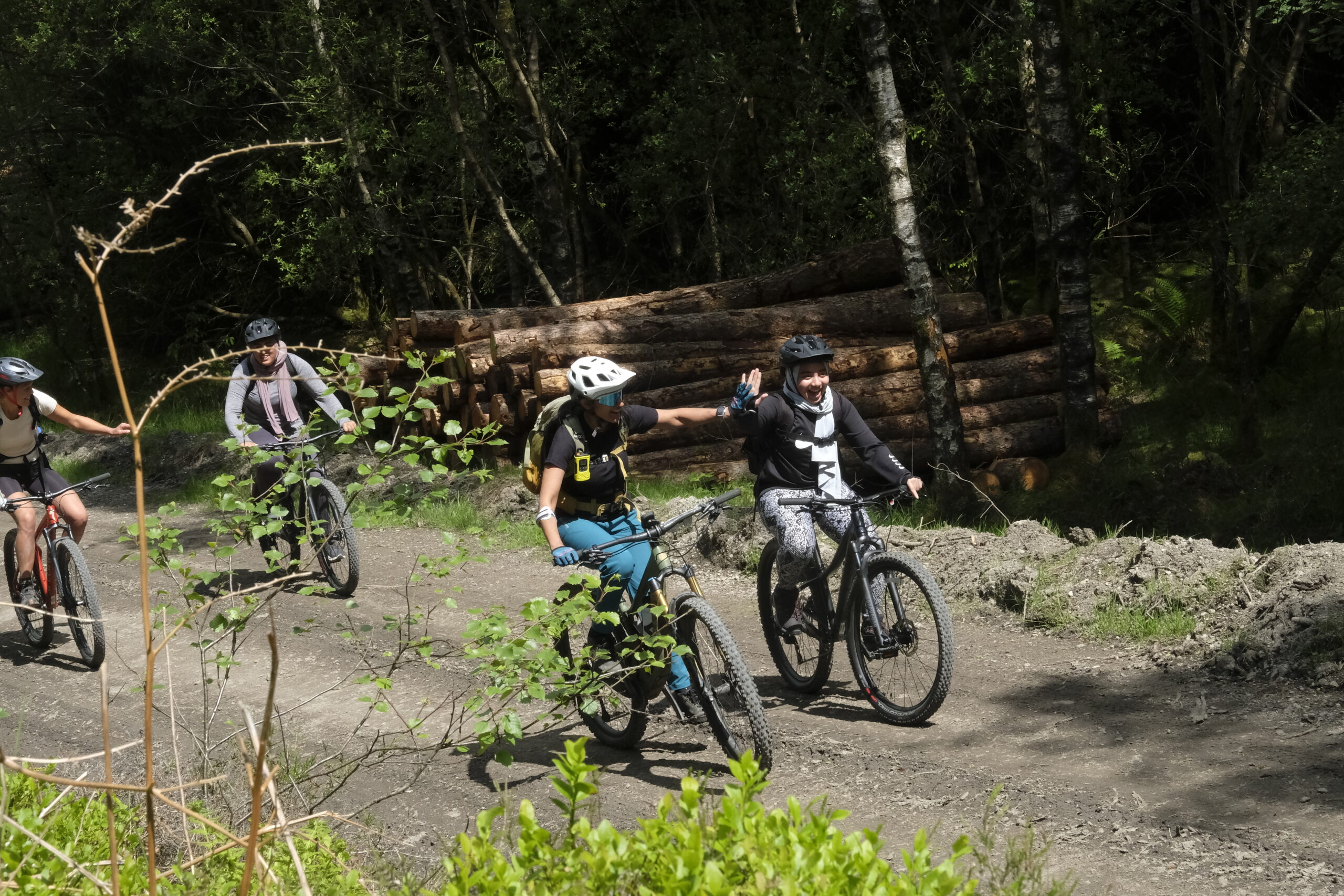
As well as the dull-but-important policy side of things, how about a few more of those glossy skiing style stories about mountain biking? Some more mainstream stories that make mountain biking look fun? Sunday supplement style tales of family days out to trail centres. Aspirational shots of people looking happily muddy and troughing down fine pub meals at the end of a ride in ‘Escape for a weekend’ holiday features. Brands could easily work with tourist boards to help support this kind of messaging and plant the seeds of mountain biking as positive and fun activity in the minds of the general public.
Now yes, these holiday riders and pump track players are not immediately going to see why perhaps some footpaths make for more fun than bridleways, or why digging a line in the woods holds so much attraction. But given time, some of them will. Easy access on their doorsteps to mountain bike-like activities that place fun at their centre rather than transport or fitness seem likely to spawn riders who have the skills and interest to then venture onwards to trail centres and beyond. The more people from a broader range of backgrounds as possible the ‘get’ mountain biking, the louder the voice of mountain biking can be. Towns that want to become destinations for mountain biking will push to legitimise their trails, in order to fully realise the economic benefits of mountain bike tourism. If we can reach that position, where mountain biking is seen as an opportunity – just as a seaside town might promote its beach, a food town its restaurants, or a ski resort its pistes – then we will truly be living in the golden age of mountain biking.
I suggest that we need to reframe the image of mountain biking, shifting it from ‘dangerous sport’ to ‘fun activity’. Normalise it in this way, and we will have a broader range of participants that paves the way for more support right up to the most technical of trail options.
Now then, who’s with me? And who thinks I’m talking nonsense? Head to the comments for the internet version of the breakout group and workshop.




